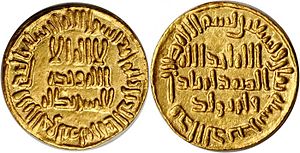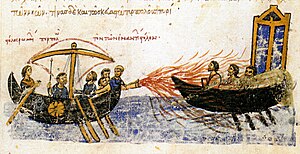Sulaimān ibn ʿAbd al-Malik



Sulaimān ibn ʿAbd al-Malik ( Arabic سليمان بن عبد الملك, d. AD 717) was the seventh caliph of the Umayyads (AD 715–717).
After his father Abd al-Malik (AD 685-705) had chosen Sulaimān to succeed his brother al-Walid I (AD 705-715), he entered the government after his death.
At first there was some unrest in the administration of the eastern provinces when Sulayman deposed and persecuted the officials of al-Hajjaj , the governor of Iraq (AD 694-714). This also led to the revolt of Qutaiba ibn Muslim in Khorassan , which was quickly suppressed.
The most significant event of his short reign, however, was the siege of Constantinople in AD 717 and AD 718, which was catastrophic for the Arabs .
How important these plans of conquest were for Sulaimān can be read in the 8th century chronicle of Pseudo-Dionysius of Tell Mahre . It says: Sulaimān, King of the Arabs, said: "I will not give up the fight with Constantinople until I have forced my way into it, or I will surrender the entire territory of the Arabs to annihilation."
According to Arab sources, Sulaimān pursued the attack project because a prophecy foretold that a caliph who himself bore the name of a prophet would take Constantinople. Sulaimān was the only member of the Umayyad family to bear the name of an Islamic prophet ( Solomon ).
This project of conquest was already prepared by Sulaimān's brother and predecessor, the caliph al-Walid I. However, like the first siege of Constantinople (AD 674–678) , the company failed with heavy losses for the Arabs. The extremely capable Byzantine Emperor Leo III. was able to stop the onslaught of the troops of the caliph Sulaimān and his successor Umar II on Constantinople with the help of a weapon technology innovation, the Greek fire . Two months after the siege began, Sulaimān died either on September 22nd or October 1st, 717, and his successor, the Caliph Umar II , continued the siege for ten months without success.
For the history of Europe, the defense of Constantinople (AD 717-718) under the leadership of the Byzantine emperor Leo III. of great historical importance. With the almost complete loss of the Arab fleet, the Arabs' maritime domination in the eastern Mediterranean was broken for decades. On the straits between the Black Sea and Aegean Sea, the advance of the Muslims, who at that time controlled over half of the Mediterranean coast, had been halted.
Without the defense of Constantinople, the gate for Islamic expansion into Europe would have been open. The defense of Constantinople (AD 717–718) was of essential importance for the development of medieval Europe. The defense of the troops of the caliphs Sulaimān and Umar II. By Emperor Leo III. represents the eastern counterpart to the Battle of Tours and Poitiers in 732 to defend Europe against Islamic expansion.
Sulaimān's successor was the caliph Umar Ibn Abd al-Aziz also called Umar II, who ruled from AD 717 to AD 720.
Cultural heritage
Sulaimān spent his brief reign mainly in Palestine , with Ramla being his preferred residence. Sulaimān has long been credited with building the Qusair 'Amra desert castle in present-day Jordan, known for its erotic wall paintings . However, recent research ascribes it to Caliph Al-Walid II (AD 743-744).
The poet al-Farazdaq (* around AD 641; † AD 728/730) compared Sulaimān in a poem of praise to the character of his actions with the Prophet Mohammed . This poem says:
ǧuʿilta li-ahli l-arḍi amnan wa-raḥmatan
wa-barāʾan li-āṯāri l-qurūḥi l-kawālim
ka-mā baʿaṯa Llāhu n-nabīya Muḥammadan
ʿalā fatratin wa-n-nāsu miṯʾim l-bahā
You were sent to the people of the earth for protection and mercy,
and to heal the traces of painful wounds,
just as God sent the prophet Muhammad
after a period of time when people were like animals.
In the religious literature of Islam, the report of an encounter between Sulaimān and the Medinan ascetic and traditionalist Abū Hāzim (died 757) found wide resonance. Accordingly, while staying in Medina, Sulaimnān sent to Abū Hāzim to hear hadiths from him . Abū Hāzim, however, showed no interest in meeting the ruler. When he was finally brought in, he gave Sulaimān a long sermon in which he reproached him for his excess and exhorted him to look to the afterlife. The report serves as a teaching example in religious literature for the correct behavior of pious people towards secular rulers. Following the example of Abū Hāzim, one should keep away from them as much as possible.
literature
- Reinhard Eisener: Between fact and fiction. A study on the Umayyad caliph Sulaimān b. Abdalmalik and his picture in the sources . Harrassowitz, Wiesbaden 1987, ISBN 3-447-02739-8 (also dissertation, University of Tübingen 1986).
- Ulrich Haarmann (first), Heinz Halm (Hrsg.): History of the Arab world . CH Beck, Munich 2001, ISBN 3-406-47486-1 .
- Stephan and Nandy Ronart: Lexicon of the Arab World. a historical-political reference work . ("Concise encyclopaedia of Arabic civilization"). Artemis Verlag, Munich 1972, ISBN 3-7608-0138-2 .
- John J. Saunders: A history of Medieval Islam . Routledge, London 1990, ISBN 0-415-05914-3 (reprint of the London 1965 edition).
- Julius Wellhausen : The Arab Empire and its fall . DeGruyter, Berlin 1960 (reprint of the Berlin 1902 edition).
- EW Brooks: The Campaign of 716-718 from Arabic Sources . In: The Journal of Hellenic Studies 19, 1899, pp. 19–33.
Individual evidence
- ↑ Archeology-online ( Memento of the original from December 18, 2016 in the Internet Archive ) Info: The archive link was automatically inserted and not yet checked. Please check the original and archive link according to the instructions and then remove this notice.
- ↑ Cf. Muḥammad Karīm Aḥmad: Šiʿr al-Farazdaq baina aṣdāʾ al-ǧāhilīya wa-ṣaut al-Islām. Maṭbaʿat al-Amāna, Cairo, 1988. p. 150.
- ↑ Cf. Eisener: Between fact and fiction. 1987, p. 157.
- ↑ See Eisener 195-205.
| predecessor | Office | successor |
|---|---|---|
| Al-Walid I. | Umayyad Caliph 715–717 |
Umar Ibn Abd al-Aziz |
| personal data | |
|---|---|
| SURNAME | Sulaimān ibn ʿAbd al-Malik |
| ALTERNATIVE NAMES | سليمان بن عبد الملك (Arabic) |
| BRIEF DESCRIPTION | Umayyad Caliph |
| DATE OF BIRTH | 7th century |
| DATE OF DEATH | 717 |
